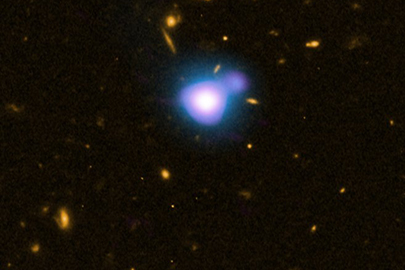Jan 3 2013
Our understanding of the early universe has taken a small step forward thanks to the discovery of a new record-setting X-ray, emitting jet. The research was a collaboration of astronomers led by Teddy Cheung Ph.D. ’04, and included Professor of Astrophysics John Wardle, Doug Gobeille Ph.D. ’10 and four other scientists. It was detected with the Chandra X-Ray Observatory, and observed with the Hubble Space Telescope and with the radio antennas of the Very Large Array in New Mexico.
 X-ray jet from quasar GB 1428, located 12.4 billion light years from Earth
X-ray jet from quasar GB 1428, located 12.4 billion light years from Earth
The jet is produced by a supermassive black hole at the center of a quasar known as GB 1428+4217 (or GB1428 for short), located 12.4 billion light years from Earth, and is the most distant X-ray jet discovered to date.
Since the age of the universe is known to be 13.7 billion years, the light and X-rays we see today left GB1428 when the universe was only 1.3 billion years old. These images therefore give astronomers new information about the physics of jets and the formation of galaxies and supermassive black holes in the very young universe.
“Quasars are galaxies with brilliant and energetic nuclei centered on massive black holes,” says Wardle. “The centers of these galaxies are so bright that they outshine the rest of the host galaxy, so photographic images appear star-like. In fact, the word quasar is a contraction of quasi-star.”
Giant black holes pull material toward them at ever increasing speed. Some of the energy of the in-falling matter generates intense radiation and often twin jets of very high-energy particles that shoot away from the black hole in opposite directions at close to the speed of light. This is called the quasar phenomenon.
Wardle says we now believe that just about every galaxy has a massive black hole right in the center, which is responsible for the energetic phenomena we see.
“Our own Milky Way Galaxy has a relatively modest black hole at its center with a mass of four million suns,” says Wardle. “The black holes at the centers of the most luminous quasars have masses of a billion suns or more.”
Research for GB1428 began when Cheung, then at Stanford, compiled a list of the most distant quasars in a large region of sky. The team set about systematically making radio images of them using the Very Large Array of 27 radio telescopes in New Mexico. The radio imaging was the Ph.D. project of Gobeille.
Cheung, who is now at the Naval Research Laboratory in Washington, D.C., said his team is excited about this result not just because it's a record-holder, but because very few X-ray jets are known in the early universe.
Co-author Lukasz Stawarz, from the Japan Aerospace Exploration Agency in Kanagawa, Japan, said since the brightness of the jet in X-rays depends, among other things, on how fast the jet plasma is moving away from the black hole, discoveries like the jet in GB 1428 tell us something about the environment around supermassive black holes and their host galaxies not long after the Big Bang.
It is believed that the X-rays are produced when the fast electrons in the jet collide with photons (particles of light) of the cosmic background radiation, which is the glow of the Big Bang. The electrons lose energy and the photons get boosted to X-ray energies.
Because the quasar is seen when the universe was at an age of 1.3 billion years, the cosmic background radiation was about a thousand times more intense than it is now. This makes the jet much brighter, partly compensating for the dimming due to distance.
Aneta Siemiginowska of the Harvard-Smithsonian Center for Astrophysics, and another co-author in the paper, said we're lucky that the universe gives us this natural amplifier and lets us detect this object with relatively short exposures, because otherwise we might miss important physical processes happening at very large distances from Earth and as far away as GB1428.
Wardle says that through the images, scientists work to understand the physics behind the X-ray jets and how they interact with the gas and light around them. GB1428 also presents the severe problem of understanding how a galaxy with a supermassive black hole at its center has already formed within the 1.3 billion years that has elapsed since the Big Bang.